Applications of PSCAD/EMTDC
Applications of
PSCAD® / EMTDC™
Manitoba HVDC Research Centre Inc.
244 Cree Crescent, Winnipeg, Manitoba R3J 3W1 Canada
�
We would like to acknowledge Dennis Woodford for the contribution
he made to this PSCAD Application Guide
�
Applications of PSCAD/EMTDC
Table of Contents
Chapter 1:
Introduction ................................................................1
Where PSCAD Can be Used ............................................................1
Chapter 2:
Traditional Transient Studies .....................................5
Sources ...........................................................................................5
Thevenin Voltage Sources ...........................................................5
Load Flow Set-up with a Source ..................................................5
Setting the Load Flow with a Generator ......................................6
Multiple Run ...................................................................................7
Energizing Transients ......................................................................8
Breaker Pre-Strike .......................................................................8
Switching Surge Data Requirements ..............................................9
System Equivalents for Switching Surge TOV Studies ...................9
Power Flow Conditions .............................................................10
Transmission Line Data ..............................................................10
Transformer Data ......................................................................11
Circuit Breakers .........................................................................11
Surge Arresters .........................................................................11
Shunt Reactors .........................................................................11
Shunt and Series Capacitors ......................................................12
Fast Front Study Data ....................................................................12
Station Layout ..........................................................................12
Busbar Dimensions ...................................................................13
Transformer Data ......................................................................13
Transformer Winding Capacitances ...........................................13
Switching Surge TOV Studies ........................................................14
Limiting Fundamental Frequency Load Rejection Overvoltags ....14
Line Energizing .........................................................................14
Shunt Capacitor Switching ........................................................14
Transient Recovery Voltage (TRV)...................................................15
References ....................................................................................17
Exercise ........................................................................................17
Chapter 3: Controls .....................................................................19
CSMF Components .......................................................................19
Use of Slider, Switch, Button and Dial ...........................................20
Applications for CSMF Components .............................................22
Filtering with a Second Order Function ......................................22
Timer to Change a Parameter ...................................................22
Controlling an AC Source .........................................................23
Measuring Relative Phase Angle ................................................24
Building an Inverse Time Function .............................................24
Exercises .......................................................................................25
Chapter 4:
Surge Arresters .........................................................27
Arrester Model .............................................................................28
Switching Surge TOV ................................................................28
Fast Front Transients .................................................................29
Determining Fast Front Model Parameters .................................30
Applications of PSCAD/EMTDC
iii
�
Table of Contents
Fast Front Studies .........................................................................33
Modeling Transmission Lines and Buswork ................................33
Lightning ..................................................................................34
Transmission Towers ..................................................................35
Tower Footing Resistance ..........................................................35
Capacitances of Equipment.......................................................36
Back Flashover ..........................................................................36
Summary of Arrester Selection ......................................................37
References ....................................................................................38
Exercises .......................................................................................39
Chapter 5:
Transformers .............................................................41
Transformer Models ......................................................................41
Core Confi guration ...................................................................42
Ungrounded Windings ..............................................................43
Saturation ....................................................................................43
Geomagnetically Induced Currents ...............................................44
Remanence ...................................................................................45
Harmonic Measurements ..............................................................47
Load Tap Changer .........................................................................47
Phase Shifting Transformers ..........................................................48
References ....................................................................................49
Exercises .......................................................................................49
Chapter 6: DC Transmission .......................................................51
Why Use DC Transmission? ...........................................................51
DC Converter Confi gurations ........................................................52
Twelve Pulse Converters ................................................................52
Thyristor Modules .........................................................................53
Substation equipment ...................................................................53
Commutation ...............................................................................54
Converter Bridge Angles ...............................................................55
Steady State DC Converter Equations ...........................................56
Short Circuit Ratio ........................................................................57
Commutation Failure ....................................................................58
Control and Protection..................................................................59
Current Margin .............................................................................61
Voltage Dependent Current Order Limit (VDCOL) ..........................62
AC Voltage Control ......................................................................63
Special Purpose Controls ...............................................................64
Series Compensation of DC Converter ..........................................65
References ....................................................................................67
Exercises .......................................................................................68
Chapter 7: STATCOM Controls ...................................................69
Interpolated Switching ..................................................................69
Use of Pages .................................................................................70
STATCOM Control Strategy ...........................................................70
Components of Controls ..............................................................71
Phase Locked Oscillator .............................................................71
Generating the Firing Pulses ......................................................72
Control of AC Voltage or Reactive Power ..................................72
Control of DC Side Volts ...........................................................73
Multipulse STATCOM ....................................................................73
iv
Applications of PSCAD/EMTDC
�
Applications of PSCAD/EMTDC
Three Level STATCOM ...................................................................74
Improved Harmonic Performance ..............................................76
References ....................................................................................77
Exercises .......................................................................................77
Chapter 8: VSC Transmission ......................................................79
VSC Transmission Control Strategy ................................................79
Components of the Controls ........................................................80
Phase Locked Oscillator .............................................................80
When Receiving End is a Passive AC System ..............................80
Generating the Firing Pulses ......................................................81
Control of AC Voltage or Reactive Power ..................................81
Control of DC Side Volts ...........................................................81
Power Control ..........................................................................82
VSC Transmission with AC Characteristics .....................................82
Phase Angle Measurement ........................................................83
Phase Advance of Synthesized Phase Angle...............................84
Controlling Power from Synthesized Phase Angle ......................85
Example Fault Case ...................................................................85
Exercises .......................................................................................86
Chapter 9: Model Verifi cation ....................................................87
EMT Model Verifi cation Methods ..................................................87
Network Compilation ...................................................................88
Example ....................................................................................89
Load Flow .....................................................................................92
Source Control ..........................................................................92
Short Circuit .................................................................................94
Frequency Analysis .......................................................................96
Summary ......................................................................................97
References ....................................................................................97
Data Listing ..................................................................................98
Chapter 10: Using PSCAD/EMTDC Waveforms for Real Time
Testing (RTP) .................................................................................101
PSCAD RTP Recorder ..................................................................101
Output File Location ...................................................................101
Multiple Run Capability ...............................................................101
RTP Playback Program .................................................................102
Exercises .....................................................................................102
Chapter 11: Transmission Lines ..................................................103
PI Line Sections ...........................................................................104
Converting Line Data ..............................................................104
Distributed transmission Lines .....................................................105
Using Line Constants ..............................................................106
Manual Entry of Data for Bergeron Model ...............................110
Interpreting Bergeron Output in LineName.tlo File ...................112
Modeling Short Lines/Cables ...................................................113
Comparison of Line Models ........................................................114
References ..................................................................................115
Exercises .....................................................................................115
Index ..............................................................................................117
Applications of PSCAD/EMTDC
v
�
Chapter 1:
Introduction
Applications of PSCAD/EMTDC
This Workbook is designed to guide the user of PSCAD/EMTDC
through its use and application. PSCAD/EMTDC (also referred to
as PSCAD) is a simulator of ac power systems, low voltage power
electronics systems, high voltage DC transmission ( HVDC), flexible
AC transmission systems ( FACTS), distribution systems, and com-
plex controllers.
WHERE PSCAD CAN BE USED
PSCAD can represent electric circuits in detail not available with
conventional network simulation software. For example, trans-
former saturation can be represented accurately on PSCAD and
only superficially, if at all, on Phasor based simulators like power
system stability programs.
A simple classical example of the use of PSCAD is demonstrated
in the following example. A 222 km, 500 kV transmission line is
open circuited at its far end, and it’s C phase at that end is faulted.
The voltage of B phase is plotted:
It is obvious from this example that the instantaneous solution
algorithm of PSCAD and the precision achievable with it opens up
great opportunities for investigation and study.
Applications of PSCAD/EMTDC
1
�
Chapter 1: Introduction
PSCAD is used by engineers, researchers and students from utili-
ties, manufacturers, consultants, research and academic institutes.
It is used in planning, designing, developing new concepts, test-
ing ideas, understanding what happened when equipment failed,
commissioning, preparation of specification and tender documents,
teaching and research. The following are some of the studies that
can be conducted with PSCAD:
•
•
Insulation coordination of AC and DC equipment.
Traditional power system studies, including TOV, TRV,
faults, reclosure, and ferroresonance.
• Relay testing (waveforms) and detailed analysis of the
CT/VT/CCVT responses and their impact on operation.
Waveforms generated by PSCAD can be saved using
PSCAD RTP/Comtrade recorder. Then, by using RTP
Playback system, these waveforms can be used to test
physical protection and control equipment.
• Designing power electronic systems and controls including
FACTS devices, active fi lters, low voltage series and shunt
compensation devices.
•
•
•
Incorporate the capabilities of MATLAB/Simulink directly
into PSCAD/EMTDC.
Subsynchronous oscillations, their damping and resonance.
Effects of DC currents and geomagnetically induced
currents on power systems, inrush effects and
ferroresonance.
• Distribution system design, including transient
overvoltages, with custom power controllers and
distributed generation.
•
Power quality analysis and improvement, including
hamonic impedance scans, motor starting sags and swells,
non-linear loads, such as arc furnaces and associated
fl icker measurement.
• Design of modern transportation systems (ships, rail,
automotive) using power electronics.
• Design, control coordination and system integration of
wind farms, diesel systems, and energy storage.
•
•
•
Variable speed drives, their design and control.
Industrial systems.
Intelligent multiple-run optimization techniques can be
applied to both control systems and electrical parameters.
2
Applications of PSCAD/EMTDC
�
Applications of PSCAD/EMTDC
Case examples have been prepared for this Applications of
PSCAD/EMTDC workbook and most examples can be used with
the 15 node Student Edition of PSCAD.
The material is prepared to help launch the electric power en-
gineer into useful and essential studies of power systems and
controls. An understanding of the full power of PSCAD can only
come with familiarity and use.
PSCAD/EMTDC is under continual development by a team of
engineers and computer scientists at the Centre. Development
direction is guided by the Technical Review Committee and the
needs of the many users around the world.
Applications of PSCAD/EMTDC
3
�
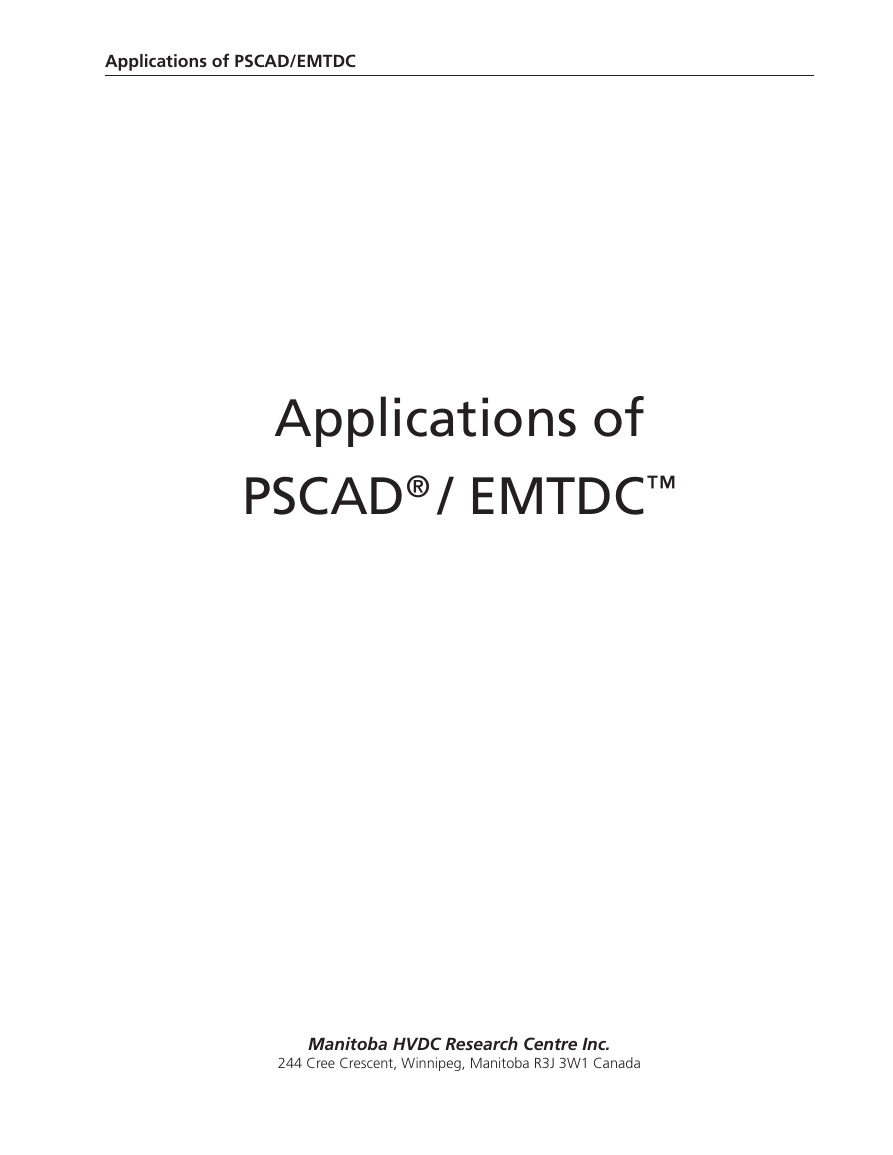

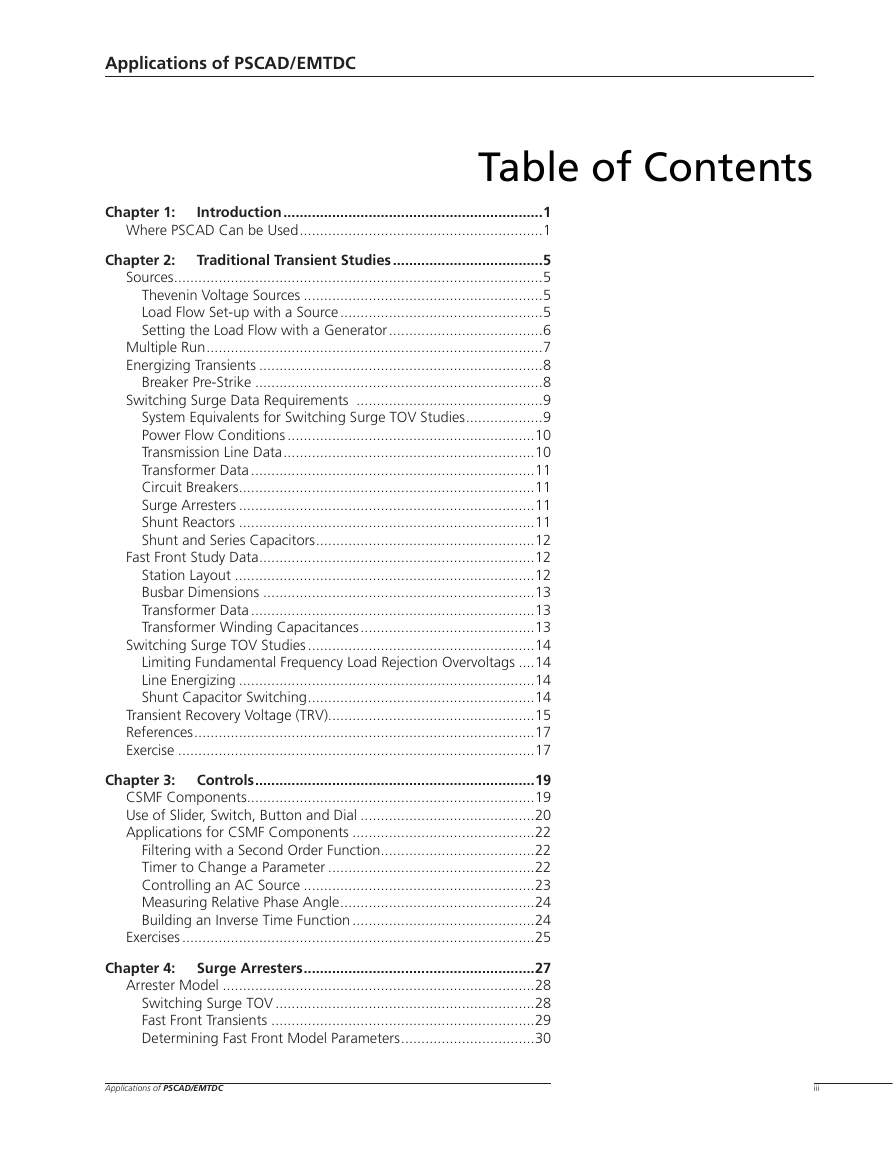
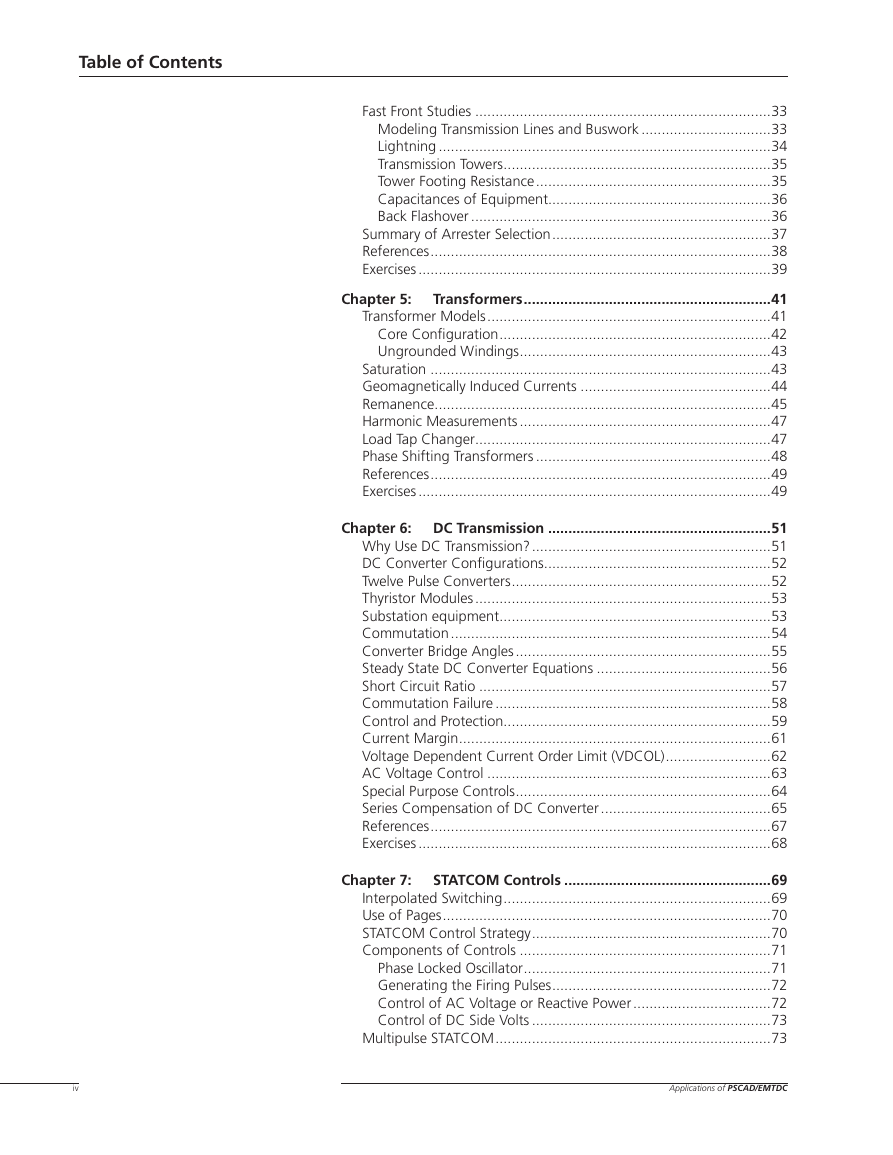
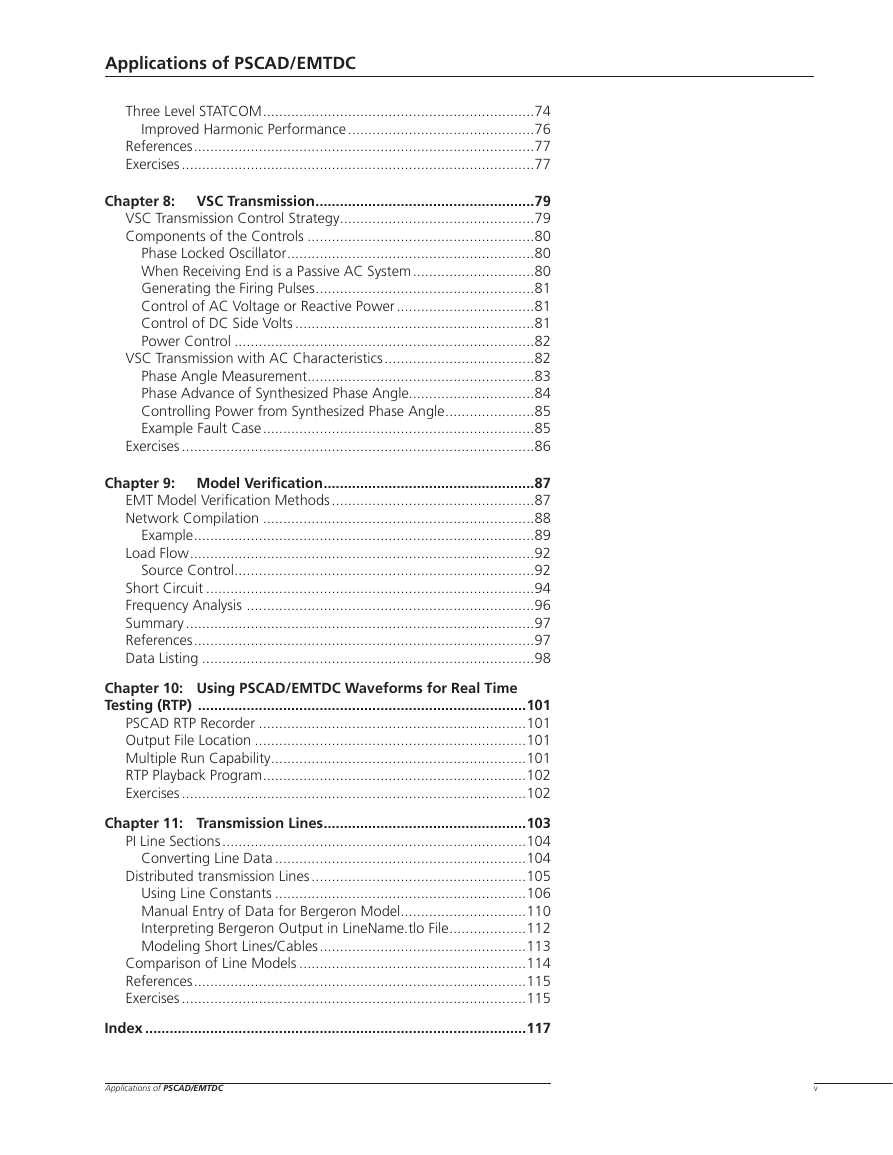
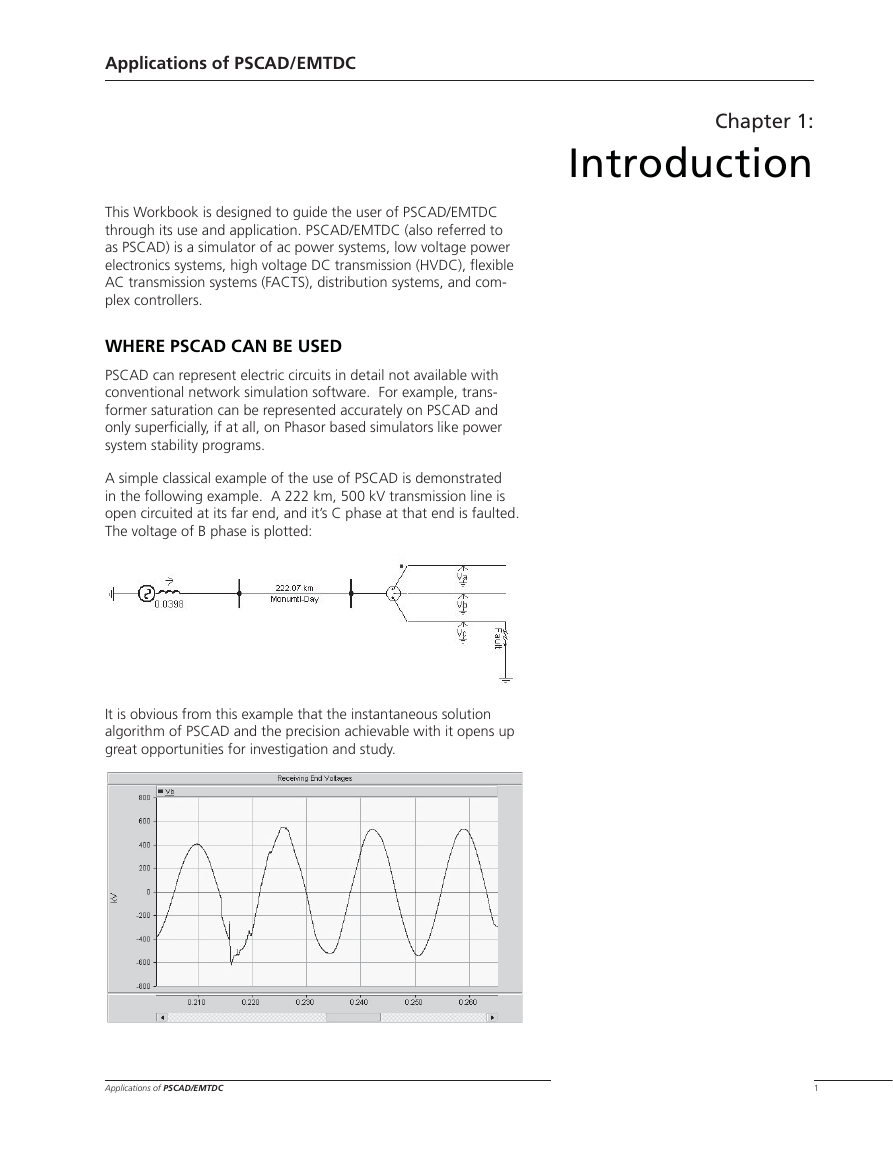
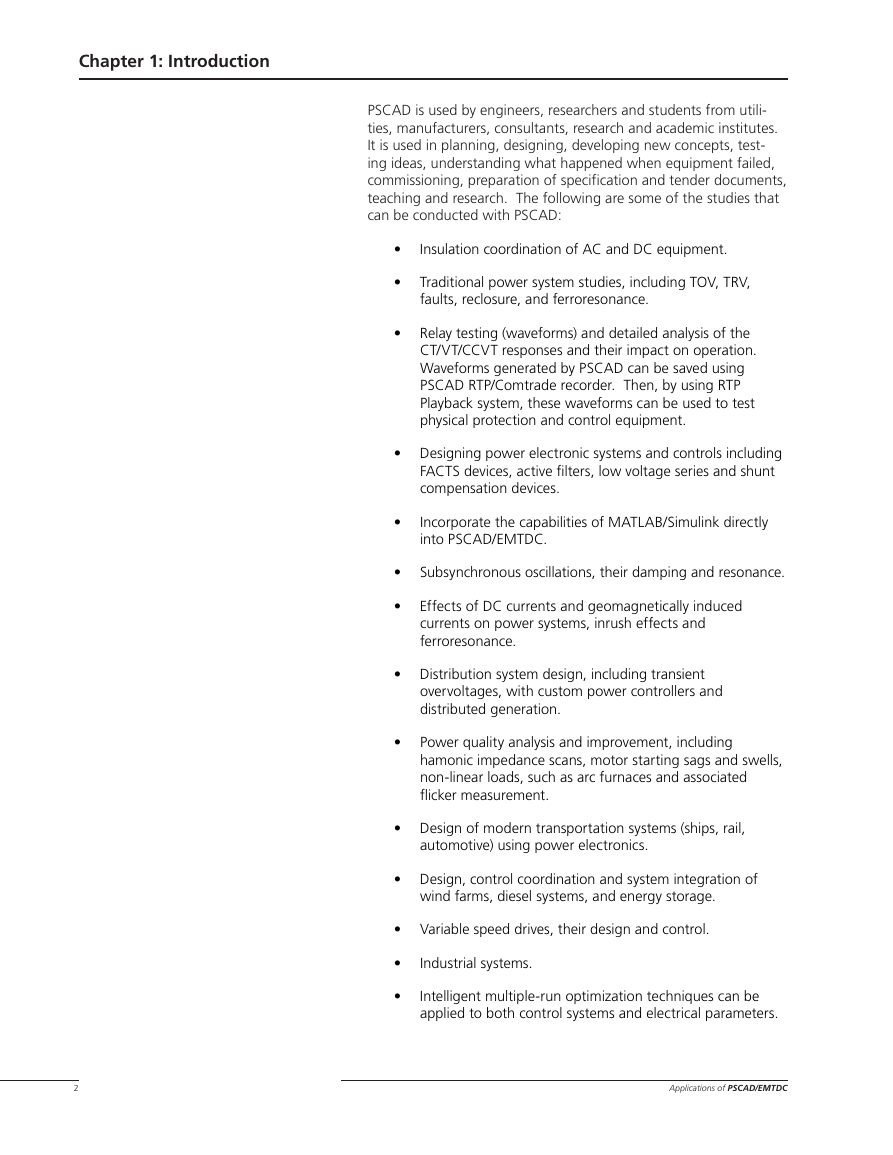









 2023年江西萍乡中考道德与法治真题及答案.doc
2023年江西萍乡中考道德与法治真题及答案.doc 2012年重庆南川中考生物真题及答案.doc
2012年重庆南川中考生物真题及答案.doc 2013年江西师范大学地理学综合及文艺理论基础考研真题.doc
2013年江西师范大学地理学综合及文艺理论基础考研真题.doc 2020年四川甘孜小升初语文真题及答案I卷.doc
2020年四川甘孜小升初语文真题及答案I卷.doc 2020年注册岩土工程师专业基础考试真题及答案.doc
2020年注册岩土工程师专业基础考试真题及答案.doc 2023-2024学年福建省厦门市九年级上学期数学月考试题及答案.doc
2023-2024学年福建省厦门市九年级上学期数学月考试题及答案.doc 2021-2022学年辽宁省沈阳市大东区九年级上学期语文期末试题及答案.doc
2021-2022学年辽宁省沈阳市大东区九年级上学期语文期末试题及答案.doc 2022-2023学年北京东城区初三第一学期物理期末试卷及答案.doc
2022-2023学年北京东城区初三第一学期物理期末试卷及答案.doc 2018上半年江西教师资格初中地理学科知识与教学能力真题及答案.doc
2018上半年江西教师资格初中地理学科知识与教学能力真题及答案.doc 2012年河北国家公务员申论考试真题及答案-省级.doc
2012年河北国家公务员申论考试真题及答案-省级.doc 2020-2021学年江苏省扬州市江都区邵樊片九年级上学期数学第一次质量检测试题及答案.doc
2020-2021学年江苏省扬州市江都区邵樊片九年级上学期数学第一次质量检测试题及答案.doc 2022下半年黑龙江教师资格证中学综合素质真题及答案.doc
2022下半年黑龙江教师资格证中学综合素质真题及答案.doc